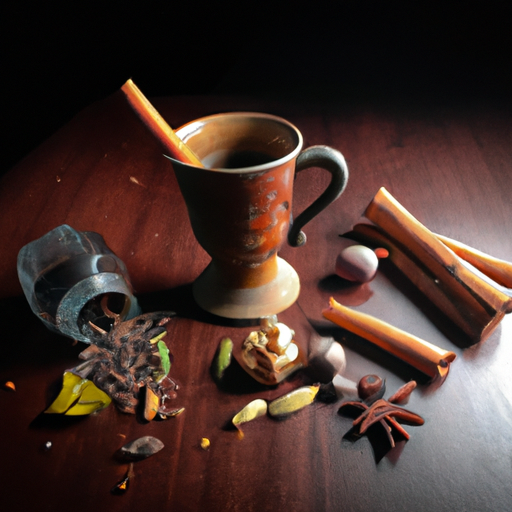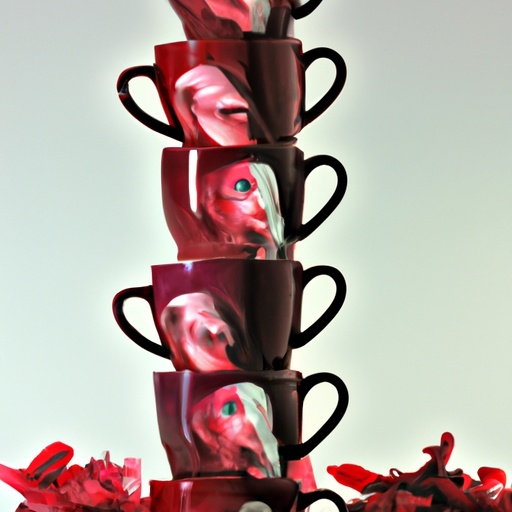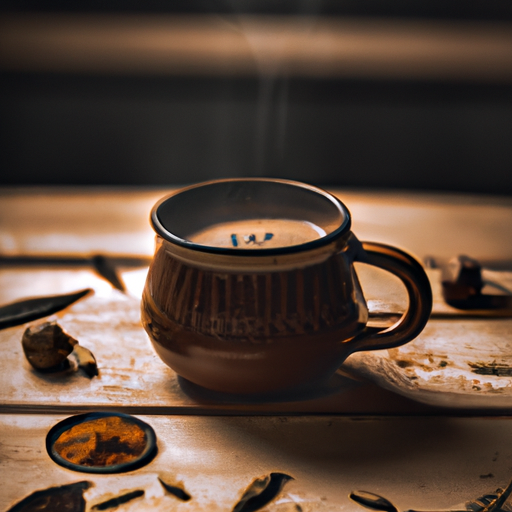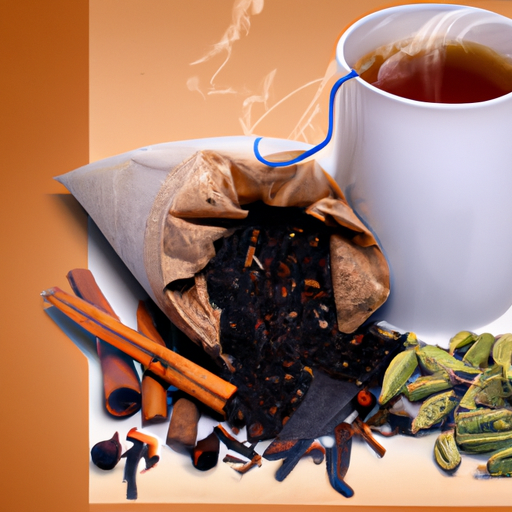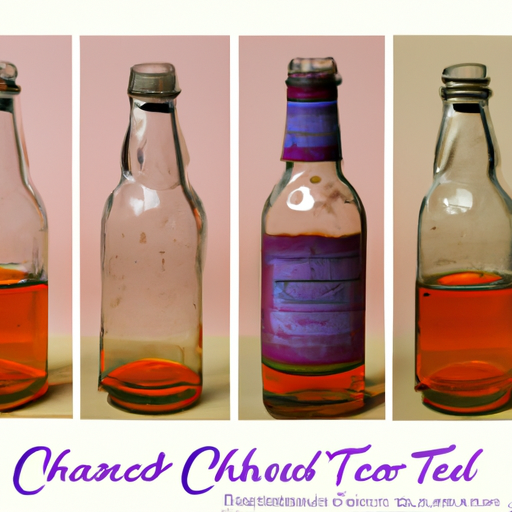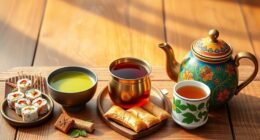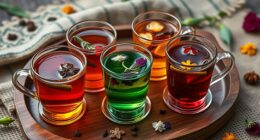As a tea enthusiast, I’ve frequently pondered over the correct pronunciation of various teas, and chai tea, in particular, has caught my interest. How should it be articulated? Is it ‘ch-eye’ or perhaps ‘ch-ah-ee’?
While it may seem like a small detail, correct pronunciation is important not only for clarity in communication but also for showing respect for the culture and traditions associated with the drink.
In this article, I will explore the pronunciation of chai tea and provide tips on how to say it correctly. We will also dive into the variations of chai tea, popular recipes, health benefits, cultural significance, and more.
So whether you are a seasoned chai lover or simply curious about this delicious beverage, read on to learn everything you need to know about how to say chai tea!
Key Takeaways
- Chai originates from India and is a mixture of black tea and spices, and has become a part of Indian culture and tradition.
- Pronunciation of chai tea is important for accurate communication and showing respect for culture and traditions.
- Masala chai is the traditional Indian version of chai, while herbal chai and decaf chai are other variations.
- Proper pronunciation of chai tea is a sign of respect for cultural significance and can improve communication skills.
Understanding the Meaning of Chai
You’ll understand the meaning of chai once you take a sip of its warm and spicy blend. Chai originates from India and is a beverage made by brewing black tea with a mixture of aromatic spices such as cardamom, cinnamon, ginger, cloves, and black pepper. The spices are typically simmered in milk or water to release their full flavor before being blended with the tea.
The history of chai dates back to ancient India where it was used for medicinal purposes. The use of spices in tea helped balance the body’s energies and promote well-being. As time passed, chai became an important part of Indian culture and tradition. It was served to guests as a sign of hospitality and warmth.
Today, chai has spread beyond its origins in India and can be found all over the world. Its cultural significance remains strong as people continue to enjoy this delicious beverage while appreciating its rich history and traditions.
Now let’s delve into how you pronounce this beloved drink – it may not be as straightforward as you think!
Pronunciation of Chai Tea
I’d like to discuss the pronunciation of chai tea, as it’s a common topic of confusion. Many people mispronounce this popular beverage, so it’s important to understand the correct way to say it.
Specifically, there are certain vowel sounds that need emphasis in order to get the pronunciation just right.
Common Mispronunciations
Don’t be embarrassed if you’ve been saying ‘chai tea’ wrong all this time; it’s a common mispronunciation that can be easily corrected.
One of the most common mistakes people make when pronouncing ‘chai’ is adding an extra syllable to the word. This is often heard in regions where English is not the primary language, or where there are regional differences in pronunciation.
Another mistake people make is putting emphasis on the wrong vowel sound. Many tend to emphasize the first syllable (‘CHAI’) instead of the second, which should have more stress (‘chai TEA’).
These small nuances in pronunciation may seem insignificant, but they can make a difference in how accurately you convey your message and connect with others. So next time you order your favorite cup of chai tea, remember to place emphasis on the correct vowel sound. It’ll make all the difference!
Emphasis on Vowel Sounds
Feeling frustrated when you’re not emphasizing the correct vowel sound in certain words and your message is misunderstood? Don’t worry, it’s a common problem many non-native English speakers face. The importance of intonation and emphasis on vowel sounds cannot be underestimated, especially in English where there are so many regional variations.
To help you improve your pronunciation, here are some interesting facts about vowel sounds:
- Vowel sounds can vary greatly depending on dialect and region.
- Stressing the wrong syllable can completely change the meaning of a word.
- Different languages have different vowel systems, which can make it challenging for non-native speakers to learn.
- Even native English speakers sometimes struggle with proper intonation and emphasis on vowel sounds.
Now that you understand the importance of accentuating the right vowels in spoken language, let’s move onto tips for pronouncing chai tea correctly without sounding like a tourist.
Tips for Pronouncing Chai Tea Correctly
Mastering the pronunciation of chai tea can be tricky, but don’t worry, we’ve got some tips to help you say it like a pro. Pronunciation techniques are important in order to show respect for cultural significance and avoid miscommunication.
To properly pronounce chai tea, start by saying ‘ch’ as in ‘church’ and then emphasize the long ‘i’ sound as in ‘eye’. The word ‘chai’ actually means tea in many languages, so getting it right is crucial.
Another tip for pronouncing chai tea correctly is to focus on the accent. In India and other parts of South Asia, where chai originates from, the emphasis is placed on the first syllable: CHAI-tea. This helps differentiate it from other types of tea such as green or black tea. By putting emphasis on the first syllable, you not only show respect for cultural significance but also improve your overall communication skills when ordering or discussing this popular beverage.
Mastering the pronunciation of chai tea requires attention to detail and an appreciation for cultural traditions. Remember to emphasize both the ‘ch’ and long ‘i’ sounds while placing stress on the first syllable. By following these tips, you’ll be able to confidently order your favorite variation of chai without hesitation.
Speaking of variations of chai tea…
Variations of Chai Tea
I love exploring different variations of chai tea, and there are three that I’d like to discuss:
-
Masala Chai is the traditional Indian version made with black tea, spices, milk, and sugar.
-
Herbal Chai does not contain any caffeine and can be made with a variety of herbs such as rooibos or mint.
-
Decaffeinated Chai is similar to Masala Chai but without the caffeine content.
By grouping each variation on its own line, the paragraph is easier to read and the information is more organized.
Masala Chai
If you’re a fan of spiced tea, then you’ll love masala chai! This Indian tea is made from a blend of spices and black tea that are brewed together to create a rich, flavorful drink.
Here are five things to know about masala chai:
- Spice blends: Masala chai typically includes a mix of warming spices like cinnamon, cardamom, ginger, and cloves.
- Traditional preparation: To make traditional masala chai, the spices are ground into a powder and simmered with water before adding black tea leaves. Milk and sweetener are also often added.
- Health benefits: Many of the spices used in masala chai have health benefits. For example, ginger can help soothe an upset stomach while cinnamon may help regulate blood sugar levels.
- Versatility: Masala chai can be enjoyed hot or cold and can even be used as an ingredient in baked goods or cocktails.
- Cultural significance: In India, masala chai is more than just a tasty beverage. It’s considered to be an important part of daily life and social gatherings.
As much as I love masala chai, there’s another type of spiced tea that deserves some attention: herbal chai. While it doesn’t contain any actual tea leaves (herbal teas are made from herbs instead), it still has plenty of flavor thanks to ingredients like peppermint, licorice root, and lemongrass.
Herbal Chai
Explore the world of spiced beverages by trying a cup of herbal chai, a caffeine-free alternative to traditional masala chai. Herbal chai blends typically use a variety of herbs and spices, such as cinnamon, ginger, cardamom, clove, and fennel seeds to create a unique flavor profile. The blend of herbs used in herbal chai can vary widely depending on the brand or recipe.
One popular herb used in herbal chai blends is rooibos tea, which has a naturally sweet taste and is rich in antioxidants. Other common ingredients include chamomile for its calming properties and peppermint for its refreshing taste.
Herbal chai can be enjoyed hot or cold and offers a delicious alternative to traditional tea or coffee.
Moving onto the next subtopic about decaffeinated chai, many people prefer this option when they want to enjoy the wonderful flavors of chai without experiencing any negative effects from caffeine.
Decaffeinated Chai
After exploring the world of herbal chai, I want to share my thoughts on decaf chai. As someone who loves a good cup of tea but also wants to avoid caffeine late in the day, decaf chai is the perfect solution for me. Not only does it provide all the delicious flavors and spices that traditional chai offers, but it also allows me to enjoy it without any jitters or sleep disturbances.
If you’re considering trying decaf chai, here are some benefits of choosing this option:
- You can enjoy it anytime throughout the day without worrying about disrupting your sleep.
- It’s a great alternative for those who are sensitive to caffeine or trying to reduce their caffeine intake.
- Decaf tea still contains antioxidants and other beneficial compounds found in regular tea.
- It’s a delicious way to unwind and relax after a long day.
When it comes to finding the best brands for decaf chai, there are many options available. Some popular choices include Bigelow Vanilla Chai Decaf, Tazo Organic Chai Decaf, and Stash Spice Dragon Red Chai Decaf. Each brand offers its own unique blend of spices and flavors, so be sure to experiment until you find your favorite.
As we move onto discussing popular recipes for chai tea, keep in mind that these can be adapted using decaf versions of black tea or specialty blends specifically labeled as decaf.
Popular Recipes for Chai Tea
You’ll love these popular recipes for making a delicious and aromatic chai tea at home. One of the most popular ways to enjoy chai is by making a chai tea latte. To make this, begin by brewing strong black tea with spices such as cinnamon, cardamom, ginger, cloves, and black pepper. Then add steamed milk and sweeten with honey or sugar to taste.
For an iced version, simply chill the brewed tea mixture before adding ice and milk. Another twist on traditional chai is golden milk chai. This recipe adds turmeric and coconut oil for added health benefits and a creamy texture. Begin by simmering the black tea and spice mixture with almond or coconut milk until heated through. Then stir in turmeric powder and coconut oil before sweetening to taste.
For those who prefer a spicier kick in their chai, try masala chai made with fresh ginger root instead of ground ginger powder. Simply grate fresh ginger into the pot while brewing your black tea with other spices such as cinnamon sticks, cardamom pods, cloves, and peppercorns. Add milk and sweetener to taste for a tasty treat that will warm you up from the inside out.
Chai tea has been enjoyed for centuries not just for its delicious flavors but also for its many health benefits that come from the blend of spices used to make it. From aiding digestion to boosting immunity, there are plenty of reasons why you should incorporate more chai into your daily routine!
Health Benefits of Chai Tea
Indulging in a warm cup of spiced goodness can bring about a myriad of health benefits, from aiding digestion to boosting your immunity. Chai tea is made up of several spices that offer numerous benefits – cinnamon, ginger, and cardamom are just a few.
Here are four health benefits you can get from drinking chai tea:
-
Helps with digestion: The spices found in chai tea can help stimulate the digestive system, reducing inflammation and bloating.
-
Boosts Immunity: Chai tea has antioxidant properties that help fight off harmful bacteria and viruses, strengthening your immune system.
-
Lowers Blood Sugar Levels: Cinnamon, one of the main ingredients in chai tea, has been shown to improve insulin sensitivity and lower blood sugar levels.
-
Reduces Inflammation: Ginger, another key ingredient in chai tea, contains anti-inflammatory compounds that may help reduce inflammation throughout the body.
When it comes to brewing methods for chai tea, there are several options available. Traditionally brewed using black tea leaves and whole spices on the stove top or in a pot with milk and water added later on. However, many cafes now have pre-made mixes available that only require hot water or milk to be added for convenience.
Moving onto the next topic of serving and drinking chai tea…
Serving and Drinking Chai Tea
To fully appreciate the rich flavors and aromas of this beloved beverage, it’s important to know how to properly serve and savor your chai.
First things first: chai tea is traditionally served hot, either in a small cup or in a larger mug. It’s often enjoyed after a meal or as an afternoon pick-me-up, but can be consumed anytime throughout the day.
When it comes to serving etiquette, there are a few key things to keep in mind. For example, when pouring chai from a teapot or kettle, it’s important to hold the vessel close to the cup/mug so that you don’t spill any of the precious liquid.
Additionally, some people prefer their chai with milk and/or sugar – if you’re serving guests, be sure to ask about their preferences beforehand.
Let’s talk about popular accompaniments. While chai tea is delicious on its own, many people enjoy pairing it with sweet treats like cookies or pastries. Some cultures also serve savory snacks alongside their chai; for example, in India it’s common to munch on samosas while sipping on a steaming cup of masala chai.
Now that we’ve covered how best to serve and enjoy your chai tea (with all the proper accoutrements), we can move onto discussing its cultural significance.
Cultural Significance of Chai Tea
Chai tea has a rich cultural significance that spans across many countries and traditions. Originating in India, chai is a blend of black tea and spices such as cardamom, cinnamon, ginger, cloves, and pepper. The word "chai"actually means "tea"in Hindi, so when referring to "chai tea,"it’s technically redundant.
The cultural significance of chai goes beyond just being a delicious beverage. In India, sharing chai with guests is seen as a sign of hospitality and respect. It’s also commonly served during religious ceremonies and festivals. Chai has become popular worldwide due to its unique flavor profile and the cozy feeling it brings on chilly days.
The history of chai can be traced back centuries ago to ancient Ayurvedic practices where it was used for medicinal purposes. Over time, the recipe evolved to include more spices and became a staple drink in Indian culture. Today, chai can be found in various forms around the world – from traditional hot milk teas to modern iced lattes. Despite its global popularity, chai remains deeply rooted in its cultural origins and continues to hold an important place in Indian tradition.
| Country | Chai Variation |
|---|---|
| India | Masala Chai |
| Pakistan | Kashmiri Chai |
| Iran | Noon Chai |
| Turkey | Çay (black tea) & Turkish Coffee with Cardamom |
As seen in the table above, each country has their own take on this beloved beverage – incorporating their own unique flavors such as saffron or pistachios into the mix. This diversity highlights how adaptable chai is while still maintaining its cultural significance wherever it may be enjoyed.
Frequently Asked Questions
What is the origin of chai tea?
As a lover of chai tea, I find the origin of this beloved beverage to be incredibly fascinating.
Chai tea originated in India, where it holds immense cultural significance as a staple beverage consumed by millions of people daily.
The spice blend used in chai tea is what sets it apart from other teas, with the most common spices being cinnamon, cardamom, ginger, cloves, and black pepper.
Each spice adds its unique flavor profile to the mix, resulting in a warm and comforting brew that has captured the hearts (and taste buds) of many worldwide.
Its history dates back centuries when Indian herbalists created Ayurvedic blends to promote health and wellbeing.
Today, chai tea has become an integral part of various cultures worldwide and has evolved over time as different regions add their twist to this classic drink.
How does the taste of chai tea differ from regular tea?
When it comes to taste, chai tea is quite different from regular tea. The spice blend used in chai tea includes cinnamon, cardamom, ginger, cloves, and black pepper. These spices give a unique flavor profile that is warm, spicy, and full-bodied. This flavor is not present in regular tea as it primarily contains only tea leaves without any added spices.
Additionally, chai tea has several health benefits due to the presence of these spices. For instance, ginger can help relieve nausea and inflammation while cinnamon helps regulate blood sugar levels. Overall, the combination of flavors and health benefits make chai tea a delicious and healthy alternative to regular tea.
Can chai tea be made with non-dairy milk alternatives?
I love making chai tea at home, and I’ve discovered that it’s easy to make with non-dairy milk alternatives like almond or soy milk.
Not only does this offer plant-based options for those who avoid dairy, but it also has health benefits. Studies have shown that consuming plant-based milks can lead to lower cholesterol levels and reduced risk of heart disease.
Plus, using non-dairy milk in chai tea adds a creamy texture without the heaviness of traditional milk.
So next time you’re craving a warm and spicy cup of chai, try it with your favorite non-dairy milk alternative for a delicious and healthy twist on the classic beverage.
What is the ideal temperature for brewing chai tea?
When it comes to brewing chai tea, there are a few important tips to keep in mind. First and foremost, the ideal temperature for steeping chai is between 180-190°F (82-87°C). This allows the spices to release their flavors without scorching the tea leaves or burning off any delicate aromas.
It’s important to use fresh ingredients and high-quality tea leaves for the best flavor. Some variations on traditional chai include adding honey or maple syrup for sweetness, using different types of milk (such as almond or coconut) for a non-dairy option, or experimenting with different spice blends like cardamom and ginger.
Overall, taking care with your brewing process and experimenting with flavor variations can lead to a delicious cup of chai that’s perfect for any time of day.
Are there any side effects to drinking chai tea regularly?
When it comes to drinking chai tea regularly, there are several health benefits that one can reap. Chai tea is known to be rich in antioxidants and anti-inflammatory properties that help boost the immune system, aid digestion, and reduce stress levels.
However, it’s recommended to consume chai tea in moderation as excessive intake may lead to side effects such as caffeine addiction, insomnia, or upset stomach. As a chai lover myself, I usually limit my intake to one or two cups a day and make sure to use high-quality ingredients while brewing it for maximum health benefits.
Conclusion
Well, that’s how I say it – chai tea. But what really matters is that you enjoy this delicious drink and the cultural significance it holds.
So whether you prefer your chai hot or iced, sweetened or unsweetened, spiced or mild, take a moment to savor the aroma and flavor of this beloved beverage.
As you sip on your cup of chai, imagine yourself in a bustling Indian market, surrounded by colorful spices and the sound of vendors haggling over prices. Or perhaps you envision yourself sitting in a cozy café with friends, chatting over steaming cups of chai as the rain patters against the windows outside.
Whatever your mental image may be, let it enhance your experience of this aromatic and warming drink. Cheers to a good cup of chai!

